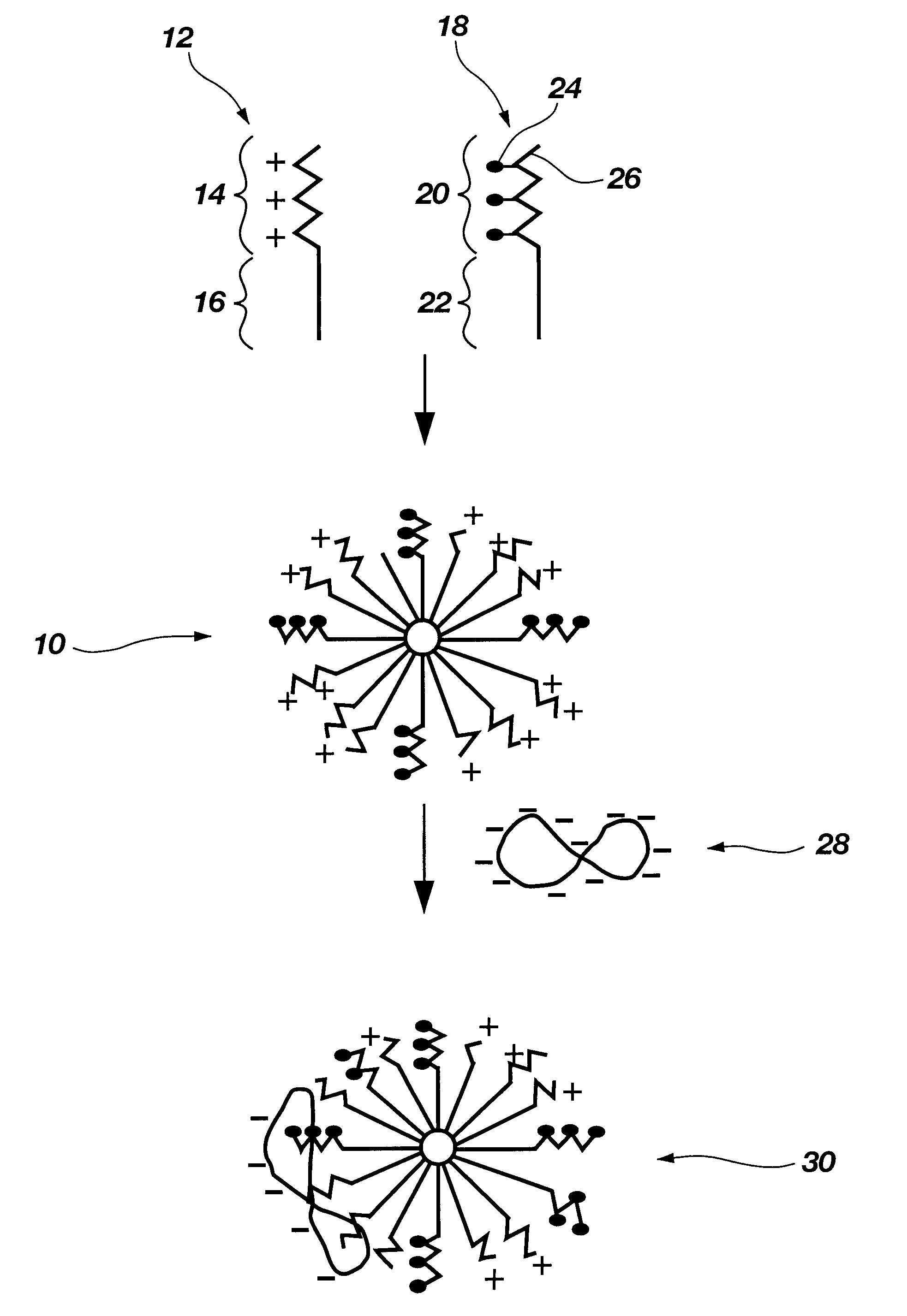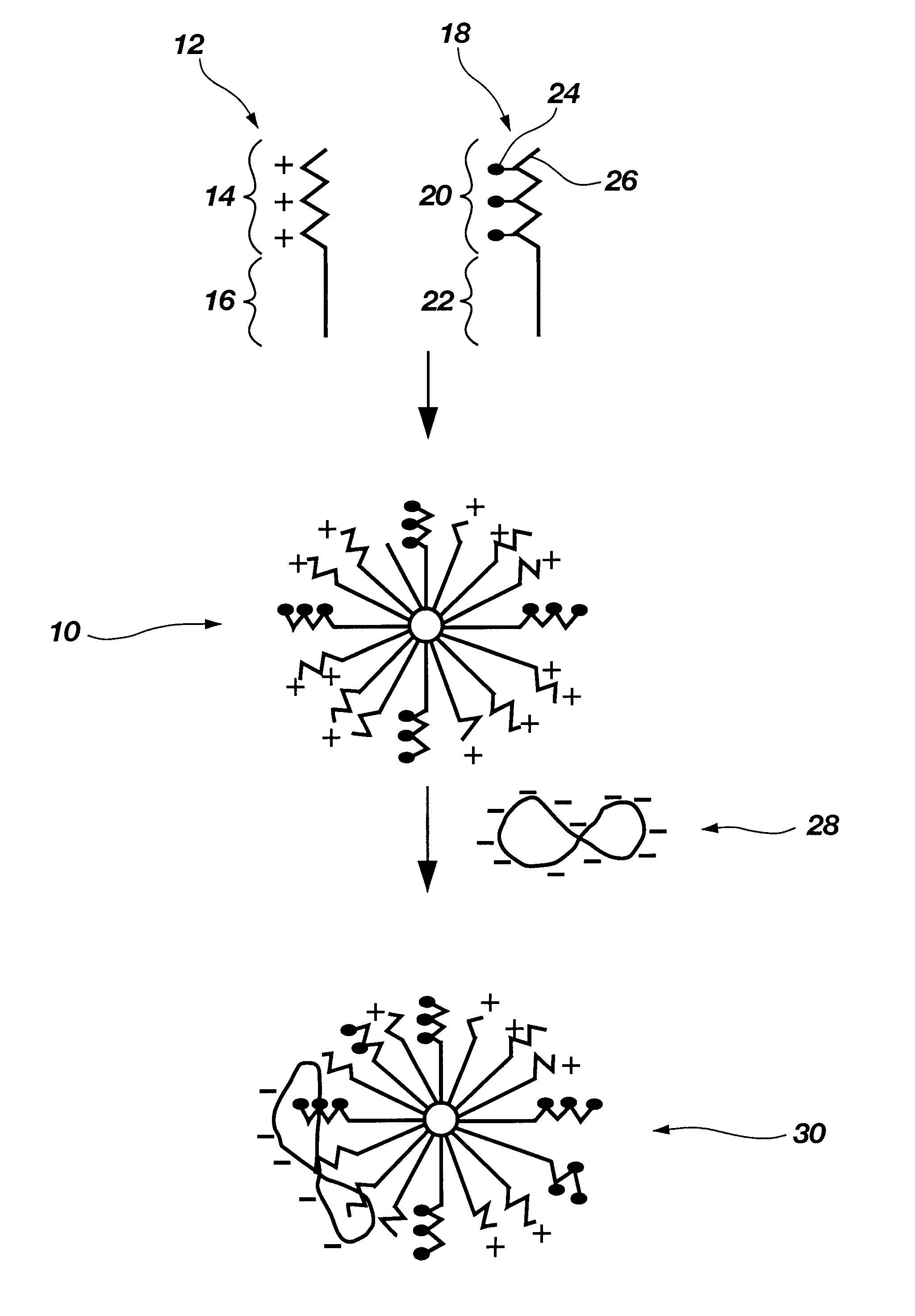Biodegradable mixed polymeric micelles for gene delivery
a technology of mixed polymer micelles and gene delivery, which is applied in the direction of capsule delivery, microcapsules, and gene material ingredients, etc. it can solve the problems of inability to deliver functionally, inability to replicate plasmids in vivo, so as to reduce cytotoxicity, reduce cytotoxicity, and reduce the kind and content of functional groups.
- Summary
- Abstract
- Description
- Claims
- Application Information
AI Technical Summary
Benefits of technology
Problems solved by technology
Method used
Image
Examples
example 2
In this example the preparation of a mixed polymeric micelle from poly(L-lactic acid)-poly(L-serine ester) diblock copolymer and poly(L-lactic acid)-poly(N-lactosyl-L-serine ester) diblock copolymer is described.
The procedure was carried out as in Example 1, except that amine-terminated poly(L-lactic acid) was synthesized by ring-opening polymerization of L-lactide initiated with N-trityl ethanolamine. N-trityl ethanolamine was prepared by stirring trityl chloride (3 g) in ethanolamine (20 ml) at room temperature. The precipitated product was obtained by filtration and purified by recrystallization in methanol-water (9:1). L-lactide polymerization was initiated with N-trityl ethanolamine in refluxed toluene in the presence of a catalytic amount of stannous octoate. Poly(L-lactic acid) was obtained by precipitation in a large excess amount of diethyl ether. The trityl group was removed using 0.1 M trifluoroacetic acid in dioxane.
example 3
In this example the preparation of a mixed polymeric micelle from poly(L-lactic acid)-poly(L-lysine) graft copolymer and poly(L-lactic acid)-poly(N-lactosyl-L-lysine) graft copolymer is described.
The mixed polymeric micelle was prepared from poly(L-lactic acid)-poly(L-lysine) and poly(L-lactic acid)-poly(N-lactosyl-L-lysine) copolymers. Poly(L-lysine) (MW 2700) was obtained from Sigma Chemical Co.(St. Louis, Mo.), and poly(L-lactic acid) (MW 1200) was prepared by polycondensation in accordance with the procedure of Example 1. The carboxyl end group of poly(L-lactic acid) was activated with an equimolar amount of isobutychloroformate and then reacted with an equimolar amount of poly(L-lysine) to yield poly(L-lactic acid)-poly(L-lysine) copolymer. The poly(L-lactic acid)-poly(N-lactosyl-L-lysine) was prepared by reacting lactobionic acid with poly(L-lactic acid)-poly(L-lysine) according to the procedure of Example 1. Various combinations of poly(L-lactic acid)-poly(L-lysine) and poly(...
example 4
In this example a transfection and cytotoxicity test of mixed polymeric micelles using HepG2 cells is described.
In vitro transfection efficiency of mixed polymeric micelles was tested on human liver carcinoma cells (HepG2) grown in MEM medium with 10% fetal bovine serum. Cells were harvested and counted using a hemacytometer and plated in 96-well plates at a density of 2.times.10.sup.5 cells / ml. One day later, various formulations of micelle-gene complexes comprising poly(L-lactic acid)-poly(L-lysine) and / or poly(L-lactic acid)-poly(N-lactosyl-L-lysine) copolymers and pSV-.beta.-gal plasmid DNA (Promega Corp., Madison, Wis.; EMBL accession No. X65335) were freshly prepared 30 minutes before transfection. The growth medium in each well of the 96-well plates was replaced by fresh growth medium without serum and the micelle-gene complexes were added to a final volume of 10 .mu.l. After a 4 hour-incubation, the growth medium was replaced with a serum-containing medium and cells were fur...
PUM
| Property | Measurement | Unit |
|---|---|---|
| Percent by mass | aaaaa | aaaaa |
| Weight | aaaaa | aaaaa |
| Amphiphilic | aaaaa | aaaaa |
Abstract
Description
Claims
Application Information
 Login to View More
Login to View More - R&D
- Intellectual Property
- Life Sciences
- Materials
- Tech Scout
- Unparalleled Data Quality
- Higher Quality Content
- 60% Fewer Hallucinations
Browse by: Latest US Patents, China's latest patents, Technical Efficacy Thesaurus, Application Domain, Technology Topic, Popular Technical Reports.
© 2025 PatSnap. All rights reserved.Legal|Privacy policy|Modern Slavery Act Transparency Statement|Sitemap|About US| Contact US: help@patsnap.com


